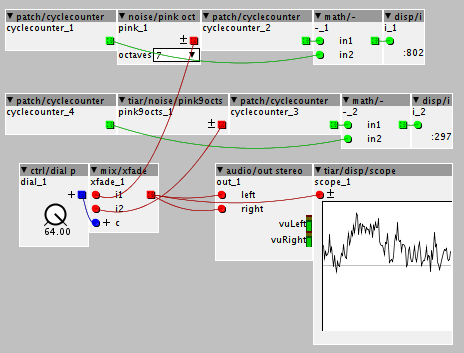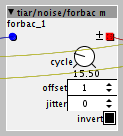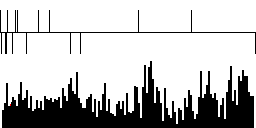You can try
menu: Help -> Library -> Community -> tiar -> string -> scroll
Tiar / SmashedTransistors Contributions
CaptainBurek Contributions
noise/pink9octs
see: menu: Help -> Library -> Community -> tiar -> noise -> pink9octs
A low CPU pink noise generator.

noise/forbac
see: menu: Help -> Library -> Community -> tiar -> noise -> forbac
This is a colored noise generator capable of some comb filter like sounds with low CPU and RAM.

It is based on a congruential pseudo random generator (overflow is not a flaw in this case)
r = r * 69069 + 1 (r being a 32 bit integer)which can be reversed with a little bit of old black magic (also known as modular linear algebra)
r = (r - 1) * -1511872763with these formulas it is possible to go forward and backward in the pseudo random sequence. (hence the name).
By doing so and by inverting some polarities it is possible to render sort of comb filtering effects.
tiar/oscBnk/paraOpt and Osc_Bnk_I
see: menu: Help -> Library -> Community -> tiar -> osc -> Osc_Bnk_I and paraOpt
These are optimized oscillator banks to simulate String Machines
paraOpt is optimized with octave doubling, no LFO inputs and octave phase locked oscillators (to replicate specificities from some eminent strings).
Osc_Bnk_I help patch has been updated.
tiar/PIT/oscLight and tiar/PIT/oscLightTri
Low CPU oscillators based on "pre integrated table" aliasing limiting.
oscLight is a low CPU oscillator.
oscLightTri contains three slightly detuned oscillators.
See the test patches in
menu: Help -> Library -> Community -> tiar -> PIT
oscLight
oscLightTri
oscLightTriPoly : an example of bright and smooth polyphonic synth 
[edit] moved to tiar/PIT
tiar/oscBnk/DyadBLI
just try menu: Help -> Library -> Community -> tiar -> oscBnk -> DyadBLI
This is a string machine object based on dyadic trains of band limited impulses.
High quality anti aliasing and 96 note polyphony.
Streichfett Exposed (Adults Only)
tiar/filter/string1
see Help -> Library -> Community -> tiar -> filter -> string1
a low CPU multitap filter that can be used to add a stringy touch to a sawtooth.
This is based on sparse FIR filters.
These filters consists in a short multitap delay line.
Delayed signals are added and substracted to generate the output.
If the tap positions are genuinely chosen, the spectral response of the filter can be quite interesting.
Here is preset 6 (inpulse response and spectral response 0 to 24kHz):
tiar/oscBnk/BLITstringFilter
96 note polyphony at 22%CPU
multitap filter of the BLITs before the integration solves many integration issues (drifting).
But it sounds more "hollow" than DyadBLI.
[update]
3 different objects that differ by
- Improved output sparse FIR filters
- octave impulse scheduling
- LFO dispatch on notes
Patch: "384"
File -> Library -> community -> tiar -> strings -> 384
Bright paraphonic synth... 384 oscillators for a single filter.
Hi there!
I'm a devout user of your Oled objects, thanks a lot for these! Today I noticed a strange quirk: If I do "embed as patch/object" with them, they stop working. Never had this with any other objects. Any idea how to fix this?
db
(I want to start messing with the code so as to save me some SRAM...)
OLEDMWE.axp (1.1 KB)
yes, since his object uses includes you cannot embed them. you will have to copy the object and the inc file to your local folder and edit that.
Thank you sir for all your marvellous contributions. And especially for your violin patch. I've adapted it a bit for use along with Linnstrument and it's a great match. I still have to find a way to make it less resonating in higher registers but it's perfect as it is. I'm working on a semi-accoustic Axoloti instrument with accoustic resonator and your patch sounds very natural to my (amateur) ears. Thanks again!
Hi @Captain_Burek,
I also use a .h file for my BLIT based oscillators. These avoid to have multiple instances of constant tables and save some memory.
The OLED object does not use double buffering, it directly renders OLED "pages" (i.e. bands of 8 pixels) based on the connected scope object and strings.
Hi @cube48,
The Linnstrument is quite an impressive device.
Hope you'll post a demo 
Patch: AAegypti2
File -> Library -> community -> tiar -> noises -> AAegypti2
The most annoying patch around. Use it at night if you want people to go crazy.
tiar/pata/rot
see Help -> Library -> Community -> tiar -> FDN -> rot Feedback Delay Network DelayVerb
The rot objects are elementary optimized mathematical rotation units. They have two audio rate inputs and two audio rate outputs. The outputs are a rotation of the input pair.
One interest of this rotation operator is that it preserves signal energy i.e. the sum of the squares of the inputs equals the sum of the squares of the outputs. They can be used for stable feedback patches.
The help patch "rot Feedback Delay Network DelayVerb" shows how to use them as a "feedback matrix" in a chorusing feedback delay network (FDN).
[edit] moved to tiar/FDN
tiar/noise/
All these objects have help/example patches so that you can try them:
In the main menu see Help -> Library -> Community -> tiar -> noise -> ...
From vintage synths to others "white" or "pink" noise generators where not really close to the theoretical model. Each generator used different tricks to get the job done... hence a wide palette of noises.
Thus, here is a bunch of different noise generators using different Axoloti tricks...
sigmo
This one can generate "wind sweeps". In the low register it can sound like spacecraft boosters (at 0:20).
noiseSR
Quite similar to sigmo but brighter
ssmul
crachin
[Edit 08/08/18]
new noise objects for various purposes
tiar/noise/ velvet, colvet, randLP, sinseq, wobb
test them with the help patches in: Help -> Library -> Community -> tiar -> noise -> velvet, colvet, randLP, sinseq, wobb
velvet
A velvet noise generator. It generate random positive and negative impulses.
colvet
It generates random bursts of pseudo random signals. Good for creaking sounds.
randLP
a random modulator with a "lowpass" and a "highpass" output.
It can transform uniform noise into "fireplace" noise.
sinseq
tuned (can be pitch controlled). It generates a sound much like what old modems did.
wobb
triple wobbulated random gen. Nice for boiling sounds...
[update 10aug 18]
rain
trrum
This one has an interesting "granularity". Try high pass filters for hi hats and modulated bandpass filter for warm winds.
[update 11 aug 18]
radio
This generator sounds like an old AM radio.
xor5
A somewhat metallic noise that can be used with bandpass and highpass filters to get some classic cymbal sounds.
wobbox
Nice for rain and other liquid sounds. Technically it is a rand wobbulated box filtering noise with controllable density.
wind
Variable wind noise.
scrith
Designed for high pitched noise. "Pitch" can be controlled.
First pataphysical modelling results.
This example uses a single globulator and the implicit 16 sample feedback delay.

